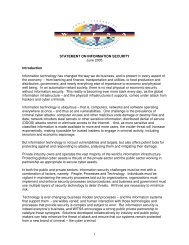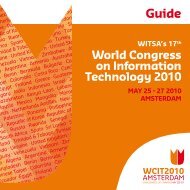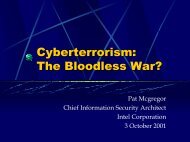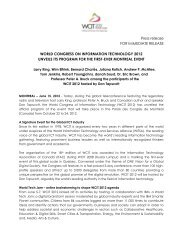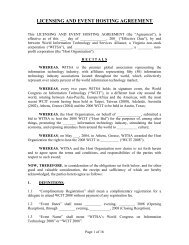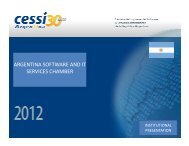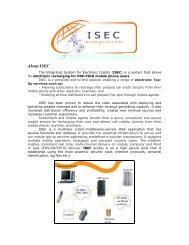Digital Planet - Executive Summary v1 - WITSA
Digital Planet - Executive Summary v1 - WITSA
Digital Planet - Executive Summary v1 - WITSA
- No tags were found...
You also want an ePaper? Increase the reach of your titles
YUMPU automatically turns print PDFs into web optimized ePapers that Google loves.
• Internet growth is exploding everywhere.The availability of Internet hosts hasincreased twenty-fold over 1992 to 25 millionin 1997. In contrast to the print- andbroadcast-dominated past, the proliferationof electronic information access providesincomparable breadth and depth of informationfor rich and poor nations and individualsalike — in many cases, life-enrichinginformation (see Figure 3).The Internet and the availability of affordablecomputing solutions have lowered many of thegeographical boundaries that hindered ICTdevelopment. This is enabling the creation of aglobal market for technology products and services.The last five years have witnessed thebeginning of a shift in the traditionalnorth/south divide separating the “haves” and“have-nots” (see Figure 4).Formerly thought of as “emerging markets,”Brazil and the People’s Republic of China (PRC)now rank among the 10 predominant ICT marketsin the world as of 1997. This demonstratesthat ICT beneficiaries are no longer confined tothe most developed and wealthiest nations inthe world.While the increases in ICT spending are visiblein all countries, the technology focus of these investmentefforts differs from region to region. Advanced markets(United States, Canada, Japan, and many Western Europeancountries) are focusing on maintaining their existingICT infrastructures and increasing efficiency by investingin software and IT services.Emerging markets, on the other hand, are now concentratingtheir efforts on building basic telecommunications andcomputer infrastructure. These markets are now moreinviting to ICT vendors because they have the knowledgeand desire to absorb the vendors’ products.Conclusions(US $B)7006005004003002001000North WesternAmerica EuropeFigure 41997 ICT Spending by RegionJapanICT Market SizeAsiaPacificLatinAmericaMiddleEast/Africa1992-1997 CAGREasternEurope(% CAGR)16%14%12%10%KEYFINDING: The “have-nots” are gaining on the “haves.” Emerging marketsare investing more rapidly in ICT than the larger, more developednations.Source: <strong>WITSA</strong>, International Data Corporation, 1998number of devices used to access the World Wide Web was78 million; by 2002, the number of Web devices willincrease to more than 515 million.Growth of this magnitude is exciting — and challenging.The creation of basic infrastructure for the information age— reliable electrical sources, basic analog telecommunications,a highly literate workforce — remains a dauntingchallenge for many developing countries. Hardware, software,and communication costs are still too high for manyof these nations. Key potential productivity improvementareas such as enhanced telecommunications bandwidth,digital cash, and electronic privacy and security controlsneed further development. Once developed, their deploymentmust be widespread to provide full benefits to all.8%6%4%2%0%The global ICT market is huge and booming. However,the best may be yet to come. IDC forecasts almost 100 millionpeople will be able to access the World Wide Web bythe end of 1998, and 320 million by 2002. In 1997, theWhile the ICT industry alone can drive much of theprogress, governments and other organizations must alsolend a hand to address these critical areas and activelyencourage deployment of ICT. Not surprisingly, then, the<strong>Digital</strong> <strong>Planet</strong> — The Global Information Economy Page 5


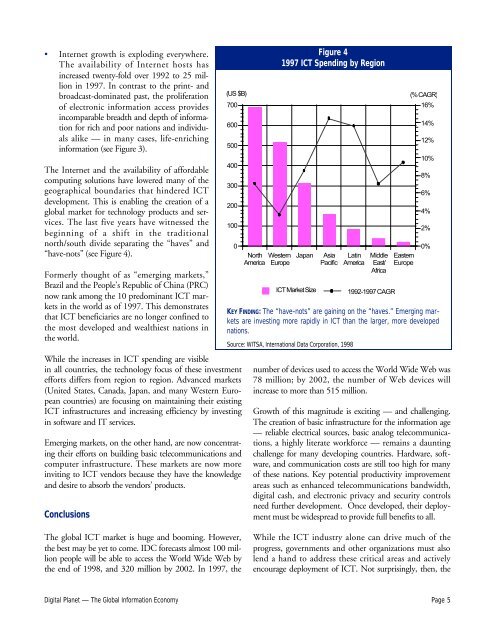
![witsa-[association member] ict excellence awards program](https://img.yumpu.com/51340170/1/190x245/witsa-association-member-ict-excellence-awards-program.jpg?quality=85)
